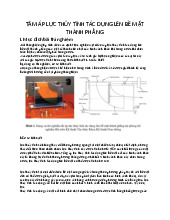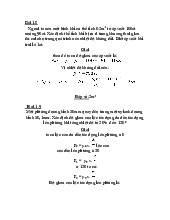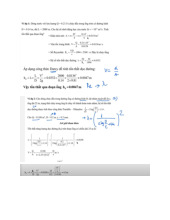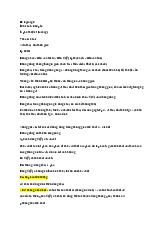

Preview text:
CƠ LƯU CHẤT
BÀI TẬP CÁ NHÂN CHƯƠNG 1 Lưu ý:
1. (1 point) What is the definition of a fluid? A fluid can be either a liquid or a gas,
•compare the differences between a liquid and a gas in term of their properties change
Hình thức: đánh máy hoặc viết tay trên giấy A4, bằng tiếng Việt hoặc bằng tiếng Anh
•(density, compressibility, viscosity, surface tension) by temperature and pressure.Nộp bài
trong vòng 1 tuần sau khi được giao bài tập
2.•(3Khuyến khích sử dụng tiếng Anh để làm bài, các bài tập trả lời bằng tiếng Anh sẽ
points) The variation in the density of water, ρ, with temperature T, in the range of 20 oC
≤ T ≤ 50 được cộng 1 điểmoC, is given in the following table Density 998.2 997.1 995.7 , 994.1 992.2 990.2 988.1 (thuật, tìm ếm tài
Tuy nhiên SV phải kiểm tra lại độ hợp lý của câu trả lời của kikg/m3) liệu. TemperatureAI nộp bài tránh ng hợp h sai.35 40 45 50 trước khi để20 trườ25 dịc30 (oC)
• SV được khuyến khích sử dụng các công cụ hỗ trợ, AI như ChatGPT, Copilot để dịch
• Ví dụ: AI sẽ dịch “density” thành “mật độ”, nhưng trong môn Cơ lưu chất, “density” là “khối lượng riêng”
Use these data to determine an empirical equation of the form ρ = c1 + c2T + c3T2 which
can used to predict the density over the range indicated. Compare the predicted values
with the data given. What is the density of water at 42.1 oC.
Hint: Search the term “How to use Excel for 1st, 2nd,3rd order regression”
3. (3 points) Rotational viscometer (rheometer) is an equipment to measure a fluid’s
viscosity. A typical rotational viscometer work on the principle that the torque required to
turn an object in a fluid is a function of the viscosity of that fluid. From the
measurements of rotational speed of the solid body and the required torque, the viscosity
is calculated. Under the Dr. Quy’s guidance, one student used the HAAKE RheoStress 1 in our faculty
lab to measure viscosities of his lotion. The results of his experiment are given in the following table:
Rate of shear strain in 1/s 0.01178 0.01871 0.03548 0.06716 0.1269 0.2396 0.4522 0.8533 1.611 3.04 Shear stress in Pa 4.074 4.137 4.91 5.949 7.26 8.905 10.98 13.55 16.48 19.44 Use these data to determine:
- Type of the fluid? (Newtonian or non-Newtonian)
- A relationship between rate of shear strain and shear stress?
- The apparent viscosity of the fluid?
Hint: Search the term “Power Law Model for fluids”
4. (2 points) Oil spills can create disastrous environmental problem. When spilled, most oils
tend to spread horizontally into a smooth and slippery surface, called a slick. There are
many factors which influence the ability of an oil slick to spread, including the size of the
spill, wind speed and direction, and the physical properties of the oil. These properties
include surface tension, specific gravity, and viscosity.
Choose one correct answer to fill in the ... and explain your
answers The higher the surface tension the more likely a
spill will ... a/ spread faster b/ remain in place Explanation?
The higher the viscosity of the oil the greater the tendency to ...
a/ spread faster b/ stay in one place Explanation?
5. (1 point) In a wastewater treatment plant, foam is a sticky, brown mass of bubbles that
forms on the top layer of water. While it’s common for a treatment plant to have some
wastewater foam, the problem occurs when there is so much foam that it hinders the
plant’s operations. A defoamer or an anti-foaming agent is a surfactant that reduces and
hinders the formation of foam in industrial process liquids. Explain the effect of defoamer on reducing foam.



